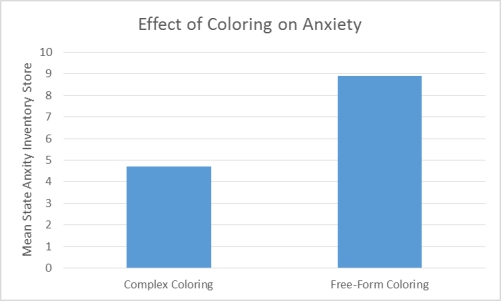Use the following to answer questions
Scenario I
Scenario I is based on fabricated data inspired by the following study:
Curry, N. A. & Kasser, T. (2005) . Can coloring mandalas reduce anxiety? Art Therapy: Journal of American Art Therapy Association, 22(2) 81-85.
Effect of Coloring on Anxiety
Curry and Kasser were interested in examining whether coloring complex geometric patterns reduces anxiety. To that end, they induced anxiety in 84 undergraduate volunteers from their university. Following anxiety induction the participants were divided into two coloring conditions. To determine which condition each participant would be in the researchers put all of their names in a hat. The first name drawn was placed in group 1, the second name drawn was placed in group 2, the third name drawn was placed in group 1, and so on. Those in the complex geometric coloring condition (group 1) were given a paper with a plaid pattern or the outline of a mandala. Those in the control condition (group 2) were given a blank piece of paper. After 20 minutes of coloring all of the participants completed a self-administered State Anxiety Inventory (SAI) . Lower SAI scores indicate low levels of anxiety whereas higher SAI scores indicate high levels of anxiety. The mean SAI scores of each coloring condition were compared to determine whether the type of coloring one does affects anxiety. The results revealed that those who colored a complex geometric pattern had significantly different levels of anxiety than those who colored on a blank sheet of paper. Curry and Kasser concluded that coloring causes a change in anxiety, but only when coloring requires a certain amount of attention and focus.
Figure 1. Effect of Coloring on Anxiety

-(Scenario I) Had participants in this study been allowed to select whether they wanted to color the mandala, the plaid pattern, or the blank paper, the researchers would have used __________ assignment.
Definitions:
Logistics
The management of the flow of goods, services, and information between the point of origin and the point of consumption to meet customer or corporation requirements.
Place
In marketing, "Place" refers to one of the four Ps (Product, Price, Place, Promotion), encompassing distribution channels, locations, or online platforms where a product or service is made available to consumers.
Human Need
A basic requirement human beings need to survive and function, such as food, water, shelter, and clothing.
Personality
The combination of characteristics or qualities that form an individual's distinctive character and influence their behaviors and attitudes.
Q6: The use of an overall score on
Q43: Dion is interested in study individual's affinity
Q51: (Scenario III) Scenario III describes that only
Q58: In order to increase the generalizability of
Q67: A t-test for independent means is appropriate
Q88: Colleen was asked about her political attitudes
Q101: An example of intra-observer reliability would be:<br>A)
Q111: (Scenario II) Suppose the vendor who sold
Q146: Dr. Hugo has 15 participants start with
Q160: Factorial designs are true experiments in which